Let the Ladies Dance
As a Duke alumna, to say that I am disappointed in their performance in the first round of the Big Dance is an understatement. Being a Blue Devil is about representing, bringing the best to the game, and then taking pride in having worked your hardest. The only member of the Blue Devil basketball team who lived up to my expectations as a fan was Coach K, who stayed classy even in loss. 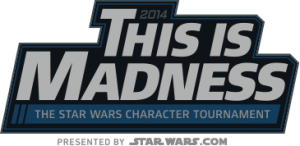 With no build-up to a next tournament game, I have time to reflect on many things. Inevitably my passions keep turning me back to reflections of the madness that is March, which brings me back around to Star Wars This Is Madness. So if you’ll bear with me, I want to tell you a story.
With no build-up to a next tournament game, I have time to reflect on many things. Inevitably my passions keep turning me back to reflections of the madness that is March, which brings me back around to Star Wars This Is Madness. So if you’ll bear with me, I want to tell you a story.
Back in 1986 as a freshman at Duke, I joined a year-old sports club called the Duke Dancing Devils. By the end of my second semester, due to my credentials as a member of the National Dance Team that had won the Lord Mayor’s Trophy for Performance in Dublin’s St. Patrick’s Day Parade and my Barr family propensity to take charge, I found myself in the position of co-captain of the squad. As a young organization, the team choreographed our own routines, obtained funds for our uniforms, and organized our schedules. Considering that the sheer volume of home games created too many basketball halftimes for the cheerleaders to cover all the performances, it seemed like a no-brainer that the Dancing Devils could fill that entertainment gap. We had a meeting with legendary Athletic Director Tom Butters, where the team was told that it would be a cold day in Blue-Deviled hell before we were welcomed into Cameron Indoor Stadium.
Was this personal? I don’t believe so. I think our presence represented change in the status quo, and institutions are historically resistant to change. The ladies of the Dancing Devils, though, were kindred spirits of Tom Butters. A lot of institutional momentum had suggested that his 1980 hire of a 34-year-old basketball coach with an unpronounceable last name had not been the smart way to go.  Yet Butters had managed to buck the “prevailing wisdom” and made his hire. Still, he’d needed to convince some people before he got to take his shot, and the Dancing Devils found themselves in the same position. We refused to take “no” for an answer – we talked to athletes and coaches, anyone who would listen – and have been performing at Duke basketball pregames and halftimes since 1987. The Dancing Devils have continued a tradition of representing the school, too, placing in the national collegiate dance team competitions.
Yet Butters had managed to buck the “prevailing wisdom” and made his hire. Still, he’d needed to convince some people before he got to take his shot, and the Dancing Devils found themselves in the same position. We refused to take “no” for an answer – we talked to athletes and coaches, anyone who would listen – and have been performing at Duke basketball pregames and halftimes since 1987. The Dancing Devils have continued a tradition of representing the school, too, placing in the national collegiate dance team competitions.
What’s the point of this story? Obviously I wear my Duke background with pride; it’s an institution I am proud to be a part of. But that doesn’t mean I can’t be critical or ask for Duke to consider change that will make it better. Anyone who has been following my blog knows that is exactly how I operate as a Star Wars fan. It’s a franchise I am proud to call my own, but that creates “cold-day in Blue-Deviled hell” situations, too. As a corporate institution, Star Wars sometimes resists change for no other reason than the inertia of the way things have been. Now with the Duke men out of the Big Dance, it’s time for this Dancing Devil to talk about her other passion: the ladies of Star Wars.
In the last two weeks, the topic of which Star Wars characters are recognizable to casual fans of the franchise has come up twice. Both times, it sparked fan reaction because the consequences of “recognizability” result in the representation of more male characters than female ones. That’s not to say it isn’t a longstanding truth of Star Wars that male characters have been better represented in the galaxy far, far away. Having blogged about the topic for a few years now, though, it’s clearly a truth to me that because “recognizability” has been viewed through a distinctively male lens, this has created a cycle where it’s difficult for female characters to gain traction.
 As I mentioned when the annual This Is Madness bracket voting launched, this year’s bracket was 16.7% female with the play-in round included. In the round of 32 only 4 female characters are included, leaving the ratio at 12.5%, identical to last year. The same day, I posed this idea on Twitter: “Thought exercise: Why couldn’t #StarWarsRebels Chopper have been female droid or Zeb the lady muscle, making it even gender representation?” One has to wonder why, in a universe so vast, almost all the droids are represented as male? And aliens specifically would seem to create a great opportunity to shake up gender norms such as men being the “designated muscle” on teams. Nancy K on Twitter points to the imposing female alien Xarcce Huwla from the X-Wing comics as an example of challenging the status quo in this manner. Obviously, we don’t know how the balance of genders will play out down the road in Star Wars Rebels, but for the main protagonists it stayed firmly rooted in the 1:2 female to male ratio that defined Star Wars from the beginning.
As I mentioned when the annual This Is Madness bracket voting launched, this year’s bracket was 16.7% female with the play-in round included. In the round of 32 only 4 female characters are included, leaving the ratio at 12.5%, identical to last year. The same day, I posed this idea on Twitter: “Thought exercise: Why couldn’t #StarWarsRebels Chopper have been female droid or Zeb the lady muscle, making it even gender representation?” One has to wonder why, in a universe so vast, almost all the droids are represented as male? And aliens specifically would seem to create a great opportunity to shake up gender norms such as men being the “designated muscle” on teams. Nancy K on Twitter points to the imposing female alien Xarcce Huwla from the X-Wing comics as an example of challenging the status quo in this manner. Obviously, we don’t know how the balance of genders will play out down the road in Star Wars Rebels, but for the main protagonists it stayed firmly rooted in the 1:2 female to male ratio that defined Star Wars from the beginning.
The unchanged ratio in the This is Madness challenge inspired Johnamarie Macias of The Wookiee Gunner and Austin Blankenship of Far Far Away Radio to team up for a post at MakingStarWars.net that proposes a gender-balanced slate of characters instead. Like the official bracket, they limited their selections to the movies and television series, which excluded the vast pool of great female characters from the Expanded Universe. Accordingly, their alternate bracket had to dig deep into The Clone Wars cast, using obscure characters Riyo Chuchi, Satine Kryze, and Nala Se. Johnamarie’s and Austin’s post illustrates the dearth of substantial female roles across the board in The Clone Wars, which explains in large part why fans are insisting on more parity in Rebels.
Following the post, Johnamarie and others had a Twitter discussion with StarWars.com’s Matt Martin, who creates and oversees This Is Madness. Matt was very receptive to fans’ concerns, and acknowledged the disparity in numbers. Referring to why mainly movie characters were selected, he explained: “This Is Madness reaches far beyond core SW fans… and there are simply more recognizable male characters at this point in the saga.”
 For the Rebellion, Johnamarie and Austin suggest play-in character Mon Mothma, who could have easily been swapped with Admiral Ackbar. The This is Madness Jedi bracket stuck firmly with the core movie Jedi, with Qui-Gon Jinn winning the play-in that included Ahsoka as the only other female Jedi. Johnamarie and Austin suggested several female Jedi who could have balanced out the gender representation and are easily recognizable from the movies and cartoon, including Jocasta Nu, Aayla Secure, and Skaak Ti. Considering Luke’s standing currently in his face-off with Obi-Wan – he is getting hammered – this might have allowed the franchise’s central hero a chance to at least have an appearance of faring better.
For the Rebellion, Johnamarie and Austin suggest play-in character Mon Mothma, who could have easily been swapped with Admiral Ackbar. The This is Madness Jedi bracket stuck firmly with the core movie Jedi, with Qui-Gon Jinn winning the play-in that included Ahsoka as the only other female Jedi. Johnamarie and Austin suggested several female Jedi who could have balanced out the gender representation and are easily recognizable from the movies and cartoon, including Jocasta Nu, Aayla Secure, and Skaak Ti. Considering Luke’s standing currently in his face-off with Obi-Wan – he is getting hammered – this might have allowed the franchise’s central hero a chance to at least have an appearance of faring better.
The Republic is where the standard of “recognizability” fell short; both Dormé and Sabé were played by actresses who are now legitimate movie stars: Rose Byrne and Keira Knightley. Instead the bracket includes Bail Organa, who has no bigger role than either of the handmaidens, and two nods to clonetroopers. As I’ve discussed previously here at FANgirl, the handmaidens are popular characters among female fans, particularly in the fanfiction community, which has been the mysterious void that the franchise still fails to understand or harness. The bounty hunters bracket continues its heavy nods to fanboy favorites with Bossk, IG-88, and Dengar pitted against Greedo. It’s worth noting that these characters owe their recognizability to the Expanded Universe and collectibles, and less so to the movies. Fans embedded deeply in the Star Wars fandom know their names and faces, but many fans of the movies simply see them as nameless background characters from a movie they enjoy. Unfortunately characters like Zam Wessell, Bo-Katan, and Aurra Sing were bypassed in favor of heavily stacking the category with fanboy favorites.
Interestingly enough, recognizability also came up in the context of the characters allowed for the fan costumers marching in the upcoming Star Wars Weekends parades, after a female fan expressed her disappointment that she would not be permitted to troop in her Mara Jade costume. Fans originally suspected a ban on Mara and most other Expanded Universe costumes had come from Disney or Lucasfilm. TFN’s Eric Geller received confirmation that the decision had been made within the 501st, including in part that “applicants are judged partly based on recognizability” and the Florida Garrison determines “which characters will resonate most [with] fans when faced with a potential cap on participants.” Apparently the decision-makers with the 501st deemed videogame male characters Revan and Starkiller sufficiently recognizable, but not the iconic Mara Jade? Brian at Tosche Station addressed the many problems with this reasoning, especially its impact of excluding many female characters. A highly ranked and well-known member of the 501st replied, acknowledging that “many of SW female face characters come from the Expanded Universe and as a result are likely not going to be approved” but noting that female fans could participate as other characters or at other 501st events. 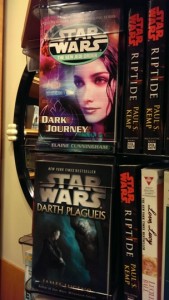 I want to reiterate, though, that in most instance non-approval decisions will be issued by the franchise itself, so when fan groups self-censor what requests they send up the chain, it means that popular female characters aren’t even being given a chance to get a no-go from Disney or Lucasfilm.
I want to reiterate, though, that in most instance non-approval decisions will be issued by the franchise itself, so when fan groups self-censor what requests they send up the chain, it means that popular female characters aren’t even being given a chance to get a no-go from Disney or Lucasfilm.
Ironically, the same weekend the news of the 501st’s Star Wars Weekends policy was developing, a friend of mine visited Hollywood Studios and texted me these pictures of the book racks and shelves at The Writer’s Stop, located near Star Tours. The Writer’s Stop has shelved many Star Wars books long before Disney bought Lucasfilm, and in the past included a strong selection of Star Wars fiction and non-fiction that was movie-centric or included movie-centric characters on their covers. The current offerings include Jaina Solo’s flagship book, Dark Journey, shelved in two separate locations (eight total copies – more than any of the other books, according to my friend’s count). Two Fate of the Jedi books, Ascension with Ben and Vestara and Abyss with the back cover turned outward to show Mara. Darth Plagueis, from the Prequel Trilogy, and Death Troopers and Riptide. Truce at Bakura, the only cover featuring familiar Original Trilogy movie characters, was 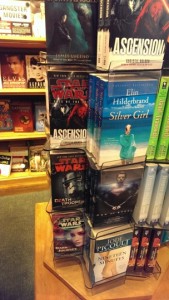 located at the bottom of the rack. The selection of Star Wars fiction was shelved near Catching Fire and Mockingjay as well as books by famous women authors Danielle Steele and Janet Evanovich. It would certainly seem, then, that Disney’s own bookstore does not think that high recognizability is a crucial ingredient to marketing Star Wars within their own parks, even within the scope of the Expanded Universe novels.
located at the bottom of the rack. The selection of Star Wars fiction was shelved near Catching Fire and Mockingjay as well as books by famous women authors Danielle Steele and Janet Evanovich. It would certainly seem, then, that Disney’s own bookstore does not think that high recognizability is a crucial ingredient to marketing Star Wars within their own parks, even within the scope of the Expanded Universe novels.
Whether it’s This Is Madness or fan cosplayers on parade, I see at least two significant reasons why EU characters should not be excluded from consideration.
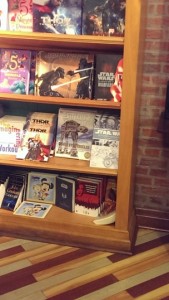 First, it is highly dubious that the best-known EU characters are less recognizable than the obscure movie characters, even among significantly less informed fans than the hardcore fandom. As I pointed out with IG-88, Dengar, and Bossk, their popularity is steeped in lore created outside the movies. Mara Jade and Grand Admiral Thrawn each are highly visually distinctive. The Thrawn Trilogy, in which they were first introduced, placed on NPR’s top 100 science fiction and fantasy books list a few years ago. Mara won the Fan’s Choice action figure voting in 2011, and Thrawn was recently released as a Gentle Giant mini-bust. Both characters also have been frequently mentioned in mainstream entertainment media and websites, far beyond the Star Wars fansites, as possibilities for appearing in Episode VII or the standalone films, or even Star Wars Rebels. It’s also worth remembering that it was Timothy Zahn who first made 501st canon in the Expanded Universe; the name is never spoken onscreen when the legion joins Vader’s attack on the Jedi Temple in Revenge of the Sith. Similarly, Jaina Solo, posed in her orange flightsuit, resulted in a sold-out bishoujo statue from Kotobukiya with such demand that it’s being reissued later this year; Jaina action figures (from 2010) often sell on eBay for more than $75. Jek Porkins, included in this year’s bracket, also has only a single action figure issued (in 2000), and you can snag him for $15 or less. Perhaps a character like Jaina doesn’t stand a chance, but neither did X-wing pilot Jek Porkins. The bracket challenge is as much about exposure to potentials fans as it is existing fans. Were the casual or potential female fan to look at the bracket and see X-wing Jaina, her most recognizable visualization, in place of Jek Porkins, I see far more upside potential gain for the franchise than what is presented by a bracket of mostly male characters. (Update: Perhaps this tweet of a young fangirl in X-wing attire makes that point best. Tweet found at Club Jade’s Twitter Roundup posted today.)
First, it is highly dubious that the best-known EU characters are less recognizable than the obscure movie characters, even among significantly less informed fans than the hardcore fandom. As I pointed out with IG-88, Dengar, and Bossk, their popularity is steeped in lore created outside the movies. Mara Jade and Grand Admiral Thrawn each are highly visually distinctive. The Thrawn Trilogy, in which they were first introduced, placed on NPR’s top 100 science fiction and fantasy books list a few years ago. Mara won the Fan’s Choice action figure voting in 2011, and Thrawn was recently released as a Gentle Giant mini-bust. Both characters also have been frequently mentioned in mainstream entertainment media and websites, far beyond the Star Wars fansites, as possibilities for appearing in Episode VII or the standalone films, or even Star Wars Rebels. It’s also worth remembering that it was Timothy Zahn who first made 501st canon in the Expanded Universe; the name is never spoken onscreen when the legion joins Vader’s attack on the Jedi Temple in Revenge of the Sith. Similarly, Jaina Solo, posed in her orange flightsuit, resulted in a sold-out bishoujo statue from Kotobukiya with such demand that it’s being reissued later this year; Jaina action figures (from 2010) often sell on eBay for more than $75. Jek Porkins, included in this year’s bracket, also has only a single action figure issued (in 2000), and you can snag him for $15 or less. Perhaps a character like Jaina doesn’t stand a chance, but neither did X-wing pilot Jek Porkins. The bracket challenge is as much about exposure to potentials fans as it is existing fans. Were the casual or potential female fan to look at the bracket and see X-wing Jaina, her most recognizable visualization, in place of Jek Porkins, I see far more upside potential gain for the franchise than what is presented by a bracket of mostly male characters. (Update: Perhaps this tweet of a young fangirl in X-wing attire makes that point best. Tweet found at Club Jade’s Twitter Roundup posted today.)
Which brings me to my second point: why ignore the future recognizability of characters, especially where female fans are concerned? A character with an intriguing look can actually create fan interest. With much speculating and clamoring about the potential of a Boba Fett standalone movie, it often seems to slip people’s minds that the now-iconic bounty hunter started out as nothing more than compelling imagery that fans gravitated toward. Boba Fett’s first appearances were simply a costume in a parade and a short animated segment of the Holiday Special. In The Empire Strikes Back he has a handful of lines in a few scenes. Yet his visual appeal, including his action figure, ultimately created a phenomenon that allowed him to be resurrected from his onscreen death. 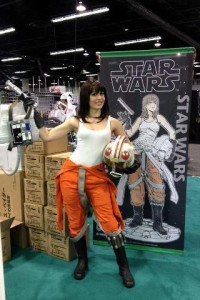 He didn’t start big like Vader or Luke; fans built him up to it because he looked cool. Many girls grew up wanting to be an X-wing pilot, as the high levels of participation by female X-wing cosplayers in the Rebel Legion demonstrates, and seeing a Jaina costume may help more girls and women realize they can find adventure in this vast universe. Other EU characters with similar potential include Sith Lady Lumiya with her mask and light-whips – she goes back all the way to the original Marvel Star Wars comics – and the striking red uniform and white-streaked hair of Ysanne Isard, who has made quite an impression in many 501st parades, too. It’s no coincidence that the Rebels character with by far the most fan art already, Sabine Wren, is also the one who’s the most visually intriguing of the core group of six.
He didn’t start big like Vader or Luke; fans built him up to it because he looked cool. Many girls grew up wanting to be an X-wing pilot, as the high levels of participation by female X-wing cosplayers in the Rebel Legion demonstrates, and seeing a Jaina costume may help more girls and women realize they can find adventure in this vast universe. Other EU characters with similar potential include Sith Lady Lumiya with her mask and light-whips – she goes back all the way to the original Marvel Star Wars comics – and the striking red uniform and white-streaked hair of Ysanne Isard, who has made quite an impression in many 501st parades, too. It’s no coincidence that the Rebels character with by far the most fan art already, Sabine Wren, is also the one who’s the most visually intriguing of the core group of six.
Whether it’s people clicking over to StarWars.com for This Is Madness or watching the 501st parade from the sidewalk at Star Wars Weekends, the goal shouldn’t be just to trigger “Oh, I know who that is!” but also to catch attention with the “Wow, who’s that? They’re awesome!” as well. So while it’s understandable that This is Madness and the Star Wars Weekends parade need to have broad appeal to the masses of casual fans, limiting the scope of featured characters to those with existing recognizability isn’t doing anything to dispel the perception that Star Wars doesn’t offer a lot for a female potential customer. Powerful evidence indicates that people gravitate most to characters they can relate to and who look like them, and Star Wars needs to show female fans that it does have many great female characters to offer, even if the casual fans might not know all their names – yet. Maybe including some cool-looking female characters will get people excited about them, just like Boba Fett a quarter-century ago.
Tricia Barr took her understanding of brand management and marketing, mixed it with a love of genre storytelling, and added a dash of social media flare to create FANgirl Blog, where she discusses Star Wars, fandom, and strong female characters. She also writes about Star Wars for Random House’s science fiction and fantasy blog Suvudu.com and Star Wars Insider magazine and is a contributor for Her Universe’s Year of the Fangirl. Her FANgirl opinions can be heard on the podcasts Assembly of Geeks and RebelForce Radio Presents Fangirls Going Rogue.
Tricia has completed her first novel, Wynde – a military science fiction with a fantastical twist that features heroines Vespa and Gemini. For excerpts and tales of her adventures in creating a fictional universe, hop over to TriciaBarr.com.
For updates on all things FANgirl follow @FANgirlcantina on Twitter or like FANgirl Zone on Facebook. At times she tries the Tumblr.
- Hyperspace Theories: Bad Luck Ghorman - June 2, 2025
- Hyperspace Theories: One Year Later as ANDOR Kicks Off Season Two - May 15, 2025
- REVIEW: Tales of the Underworld - May 4, 2025











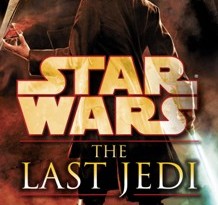
Well put, Tricia.
Although it’s being said that the bracket is for more than the core fans, it’s an excellent point that it could also serve as an introduction for other characters to people who aren’t familiar.
“Oh, I know who that is!” but also to catch attention with the “Wow, who’s that? They’re awesome!” as well. (–This.
Pingback:Fangirls Going Rogue- Episode 6: Great Hera! What’s Behind The Mask? | Fangirl Next Door
Pingback:Did Geena Davis Convince J.J. Abrams to Gender-Swap an Episode VII Character? « fangirlblog.com
Pingback:Fangirls Going Rogue Episode 6 (April 2014) – Fangirls Going Rogue